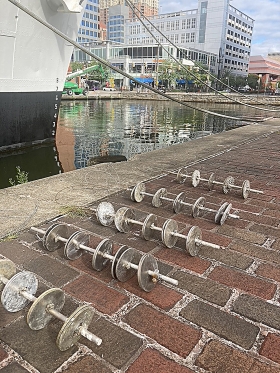Biofilms and Biodiversity Rack Design and Construction
Basic Rack Designs
Our collection of rack designs are simple and inexpensive to build. All use materials that are available at most hardware stores.

Biofilms can grow on acrylic discs, other plastic composed of PET or PET-G, and aluminum discs. Nicknamed the CD Pipeline, this design was developed by Roger Lindblom, one of the founding partners in the Virtual University Education (VIRTUE) Project. The VIRTUE Project was a partnership between the University of Gothenburg, the University of Maryland Center for Environmental Science, Maryland Sea Grant, and the University of Bergen with funding from the Wallenberg Foundation (1997). Its aim was to offer tools to teach natural sciences using ocean-based examples. The public outreach project was simple: round discs of various substrates were placed in aquatic environments to attract colonizing organisms for observation and analysis of marine biodiversity. VIRTUE Project collaborators in Sweden, Mikael Olsson and Susan Gotensparre, have continued this work and the project is expanding again with new international partners. The Virtue Project also spurred the development of these Biofilms and Biodiversity resources.
For each rack design, you will need discs with a hole drilled in the center. The size of the discs can vary, but a 10 cm width disc fits perfectly in a plastic sandwich container, baggie, or petri dish for transport to the lab and are easily viewed under a stereoscope.
A new rack design, developed with partners at American University and Georgetown University, is composed of aluminum and metal that is more sustainable for reuse and for the study of microplastics found in biofilm communities.

How Racks are Used

An interesting experiment evolves around the comparison of invertebrate communities and depth in the water. Racks of discs placed at different makes this easy to accomplish and demonstrates some observable differences in colonization as depth increases.
Discs are suspended so biodiversity can be observed for differences in three regions of the Inner Harbor: shallow water (0-1 meter), middle-level depth (2-3 meters) and deep water (3-4 meters).
Discs are also observed seasonally to identify patterns of colonization and how biodiversity differs over time. Seasonal patterns of colonization in the Inner Harbor are well-known, and diversity varies in spring, summer, and fall.
